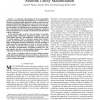Free Online Productivity Tools
i2Speak
i2Symbol
i2OCR
iTex2Img
iWeb2Print
iWeb2Shot
i2Type
iPdf2Split
iPdf2Merge
i2Bopomofo
i2Arabic
i2Style
i2Image
i2PDF
iLatex2Rtf
Sci2ools
JSAC
2006
2006
A Tutorial on Decomposition Methods for Network Utility Maximization
A systematic understanding of the decomposability structures in network utility maximization is key to both resource allocation and functionality allocation. It helps us obtain the most appropriate distributed algorithm for a given network resource allocation problem, and quantifies the comparison across architectural alternatives of modularized network design. Decomposition theory naturally provides the mathematical language to build an analytic foundation for the design of modularized and distributed control of networks. In this tutorial paper, we first review the basics of convexity, Lagrange duality, distributed subgradient method, Jacobi and Gauss
Appropriate Distributed Algorithm | JSAC 2006 | Network Utility Maximization | Resource Allocation |
| Added | 13 Dec 2010 |
| Updated | 13 Dec 2010 |
| Type | Journal |
| Year | 2006 |
| Where | JSAC |
| Authors | Daniel Pérez Palomar, Mung Chiang |
Comments (0)

